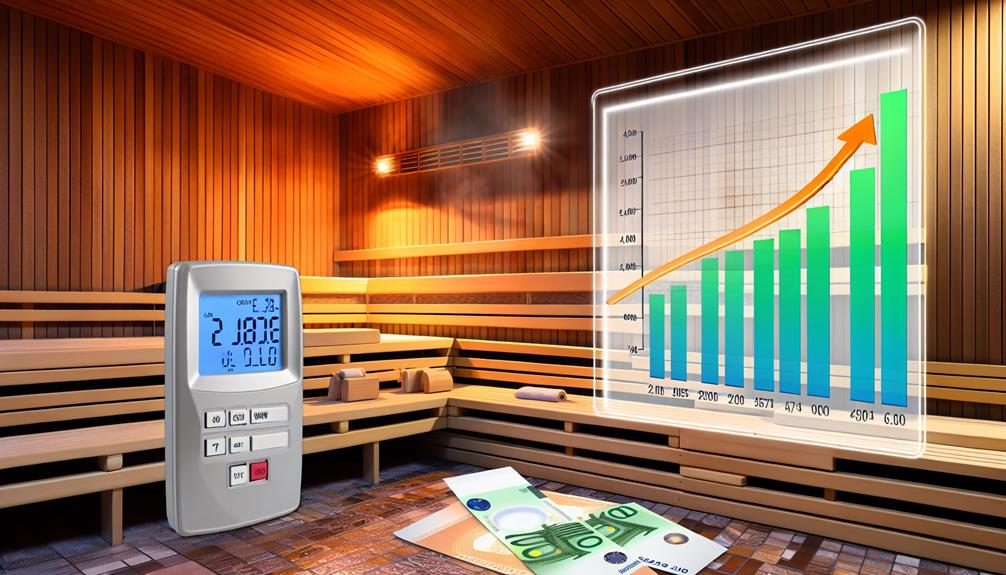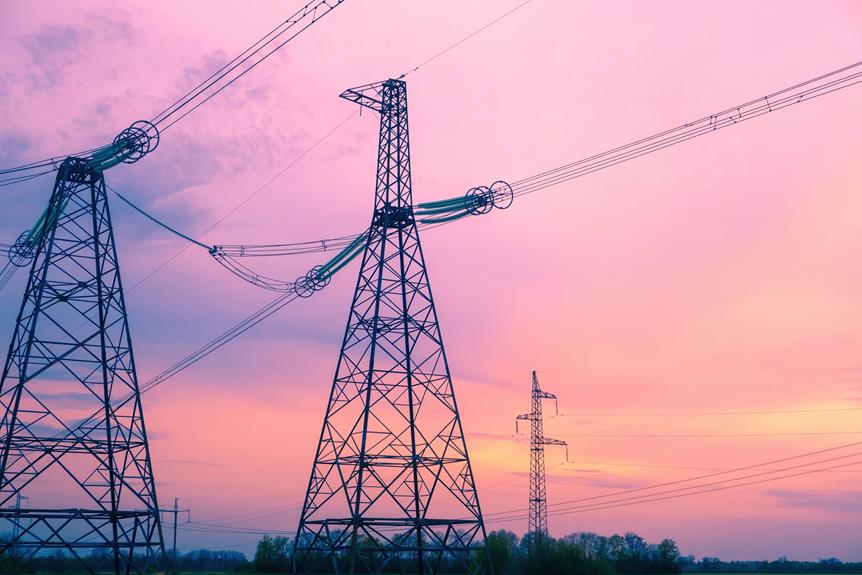Curious about the electricity consumption of your beloved sauna retreat? As you step into the soothing embrace of its warmth, have you ever pondered just how much energy it devours?
The answer might surprise you, revealing insights that could impact your sauna experience in ways you never imagined. Explore the intricacies of sauna electricity usage and discover the factors that sway the scales of power consumption in this relaxing haven.
Key Takeaways
- Sauna electricity usage depends on heater wattage and session duration.
- 6 kW heaters consume 7-9 kWh, while 8 kW heaters use 9-13 kWh per session.
- Costs vary from €2.6-€3.3 for 6 kW and €3.3-€4.8 for 8 kW in Germany.
- In the US, expenses range from slightly over $1 to $2.1 for sauna electricity usage.
Sauna Electricity Consumption Explained
When understanding sauna electricity consumption, it's crucial to consider the wattage of the heater used and how it correlates to the kilowatt-hour (kWh) consumption during each session. The power rating of the heater significantly impacts the amount of electricity consumed.
For instance, a 6 kW sauna heater typically uses around 4-5 kWh of electricity in the first hour and 3-4 kWh in the second hour. On the other hand, an 8 kW sauna heater consumes approximately 5-7 kWh in the first hour and 4-6 kWh in the subsequent hour. This results in total electricity consumption ranging from 7-9 kWh for a session with a 6 kW heater to 9-13 kWh for an 8 kW heater.
The cost of running a sauna session is influenced by this consumption, with prices in Germany ranging from €2.6-€3.3 for a 6 kW heater and €3.3-€4.8 for an 8 kW heater. In the United States, costs vary from slightly over $1 for a 6 kW heater to $1.3-$2.1 for an 8 kW heater, depending on local electricity rates and consumption habits.
Factors Affecting Sauna Electricity Usage
Factors affecting sauna electricity usage include the size of the sauna, the quality of insulation, and the power of the heater. Larger saunas tend to require more electricity to heat up the space compared to smaller ones. Proper insulation is crucial for retaining heat efficiently, reducing the workload on the heater and consequently lowering electricity consumption. The power of the heater directly impacts how quickly the sauna can reach the desired temperature, affecting overall electricity usage. Additionally, the monthly expenses associated with running a sauna are influenced by the electricity provider's rate per kilowatt-hour.
Regular maintenance of sauna components, such as sauna stones and the heater, can contribute to decreased electricity usage by ensuring optimal performance. For those looking to minimize electricity costs in the long run, opting for a wood-burning stove can be a cost-effective alternative. Wood-burning stoves provide a traditional sauna experience while reducing reliance on electricity, making them a sustainable choice for those seeking to lower their electricity consumption.
Calculating Sauna Energy Costs

To accurately calculate sauna energy costs, consider the wattage of the heater and the duration of sauna sessions. Electric sauna heaters come in various power ratings, such as 6 kW and 8 kW. A 6 kW sauna heater typically consumes 4-5 kWh of electricity in the first hour and 3-4 kWh in the second hour, totaling around 7-9 kWh per session depending on sauna size and insulation.
On the other hand, an 8 kW sauna heater may use 5-7 kWh in the first hour and 4-6 kWh in the second hour, resulting in a total energy consumption of 9-13 kWh. In Germany, the cost per sauna session with a 6 kW heater ranges from €2.6 to €3.3, while with an 8 kW heater it varies from €3.3 to €4.8.
In the United States, the expenses fluctuate from just over $1 with a 6 kW heater to $1.3-$2.1 with an 8 kW heater, influenced by electricity rates and consumption.
Tips for Efficient Sauna Electricity Use
To optimize efficiency in electricity use for your sauna, consider implementing specific strategies that can help minimize energy consumption. One of the key aspects to focus on is the proper management of your electric sauna heater. Harvia heaters, for example, consume varying amounts of energy depending on their power rating. Additionally, being mindful of your temperature settings is crucial. Turning off the sauna heater promptly after use and adjusting the temperature to a level that is comfortable yet not excessive can significantly reduce energy consumption. By doing so, you can make your sauna sessions more energy efficient and cost-effective. Below is a table summarizing some key points to consider for efficient sauna electricity use:
| Strategy | Impact |
|---|---|
| Manage sauna heater | Reduce energy consumption |
| Optimize temperature settings | Lower electricity use and costs |
| Turn off heater promptly | Minimize unnecessary energy consumption at the end of the session |
Implementing these strategies can help you achieve a more efficient and economical use of electricity in your sauna.
Comparing Infrared Vs. Traditional Sauna Power Consumption
Comparing the power consumption of infrared saunas to traditional saunas reveals significant differences in energy usage and cost efficiency. When considering electricity consumption, infrared saunas are more energy-efficient than traditional saunas due to their design and heating method. Here's a breakdown to help you understand the disparity:
- Monthly Electricity Consumption: Infrared saunas typically consume around 120 kWh per month when operating a 6,000-watt sauna, while traditional saunas can use approximately 225 kWh per month for the same wattage sauna.
- Monthly Running Cost: The cost of running an infrared sauna is estimated to be around $14.40 monthly based on average electricity rates. In contrast, traditional saunas may cost around $27.00 per month to operate.
- Cost Savings and Energy Efficiency: The energy efficiency of infrared saunas not only contributes to lower electricity consumption but also results in significant cost savings over traditional saunas in terms of monthly operating costs.
When comparing infrared saunas vs. traditional saunas, the difference in power consumption and associated costs clearly favors the use of infrared saunas for those looking to minimize their electricity bills while enjoying the benefits of sauna therapy.
Frequently Asked Questions
Do Saunas Use a Lot of Power?
Saunas do consume a significant amount of power due to their heating elements. Factors like energy efficiency, power consumption, and environmental impact are vital. Sauna maintenance, heating technology, energy conservation, and the use of renewable sources can reduce electricity usage and carbon footprint.
How Much Does It Cost to Run a Sauna for 1 Hour?
Running a sauna for an hour requires careful management of electricity to balance comfort and costs. Optimizing your sauna's energy efficiency and usage can lead to more cost-effective operation, ensuring you get the most out of each session.
How Much Does a Sauna Add to Electric Bill?
When using a sauna, your electricity usage will increase, impacting monthly expenses. The heating costs depend on the sauna type and usage. Higher power consumption leads to elevated utility bills. Ensure energy efficiency to manage running expenses effectively.
How Much Does It Cost to Run a Sauna in Your House?
To run a sauna in your house efficiently, consider factors like energy efficiency, heating element power, temperature control, and usage patterns. Implement maintenance tips, insulation benefits, and power-saving strategies to lower operating costs and energy consumption.
Conclusion
In conclusion, the average electricity consumption of a sauna session can range from 7-13 kWh, depending on factors such as heater power and session duration.
Interestingly, a 6 kW sauna heater typically consumes around 7-9 kWh, while an 8 kW heater can use 9-13 kWh per session.
Understanding these energy usage statistics can help you better manage and optimize your sauna electricity consumption for cost efficiency.

Leave a Reply